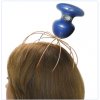Sup guys,
to add a little bit of data to maybe help in our better understanding of hairloss, I took a thermal photo of my head from above today. The main reason is that, due to contradictory publications, I am not quite sure if balding scalp tissue actually thins or thickens. My hope is that a thermal photo taken myself will help shed some light.
Background info on what you are seeing: NW3A (crown currently completely unaffected - but judging from the photo I guess it comes next). My right temple is my bad temple, i.e. more hairloss there than on my left temple. This photo was taken from above with the following orientiation: top of the photo is the back of my head, bottom of the photo is where my face is. Correspondingly, what is left on the photo would be my right temple.
I will not provide any of my own possible interpretations of the thermal photo. However, you can clearly see that the crown area leaks more heat, as does the right temple - my "bad temple".
Maybe it will be useful to someone.
Full image: http://imageshack.us/a/img13/4145/5g9c.png

This is an orientation help:
http://imageshack.us/a/img13/2458/d6z7.png
to add a little bit of data to maybe help in our better understanding of hairloss, I took a thermal photo of my head from above today. The main reason is that, due to contradictory publications, I am not quite sure if balding scalp tissue actually thins or thickens. My hope is that a thermal photo taken myself will help shed some light.
Background info on what you are seeing: NW3A (crown currently completely unaffected - but judging from the photo I guess it comes next). My right temple is my bad temple, i.e. more hairloss there than on my left temple. This photo was taken from above with the following orientiation: top of the photo is the back of my head, bottom of the photo is where my face is. Correspondingly, what is left on the photo would be my right temple.
I will not provide any of my own possible interpretations of the thermal photo. However, you can clearly see that the crown area leaks more heat, as does the right temple - my "bad temple".
Maybe it will be useful to someone.
Full image: http://imageshack.us/a/img13/4145/5g9c.png

This is an orientation help:
http://imageshack.us/a/img13/2458/d6z7.png

